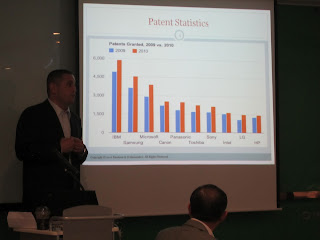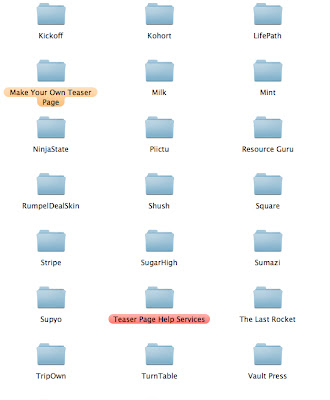From February 17th-19th, I attended and participated in an event called Startup Weekend Daejeon. From the website, Startup Weekend Daejeon is "... an intense 54 hour event which focuses on building a web or mobile application which could form the basis of a credible business over the course of a weekend. The weekend brings together people with different skillsets - primarily software developers, graphic designers, and business people - to build applications and develop a commercial case around them."
The event took place at KAIST University in Daejeon.
I came with the original intention of writing something about the event, not participating.
The first night started out rather low key; a number of entrepreneurs presented their ideas, and the attendees were expected to join up with the team/idea they liked the best.
 |
One of the presenters during the first day, with AppCenter's
Sally Park and Co Up's Seokwon Yang on the right |
 |
| Ryan Huddleston (me) speaking to Donny Lee of Wardrobe |
I quickly decided that participating would be more interesting, and joined up with one of the teams. Over the course of that night, I would go on to switch teams, and joined up with 3 other guys (one of whom I had met earlier that day). Their idea (which was called In-Home) was to create a photo sharing social networking service (much like Pinterest, pin board and all) centered around interior design. We planned some things out and decided to meet early the next morning.
 |
| Our team's first meeting! |
On the next day (Saturday, February 18th), my team met in one of the classrooms and got to work. We quickly defined our roles: 1 developer, 2 pseudo-designers, and myself (planner, for lack of a better word).
 |
In-Home: we shared our room with Reflectly, who would go
on to win 1st Prize and Best Presentation at the event |
Next, we established our team name (Glassroom). And then to the hard part; actually creating our service.
First, we wanted to look at what kind of problem we were solving. There are many photo sharing services that include pin boards. Pinterest even has a sub-category devoted to interior design. How could we go about distinguishing ourselves?
 |
| In-Home becomes Glassroom |
We decided that, although there are many photo sharing sites, most of them don't have a personal feel, and very few are devoted solely to interior design. Our company's strengths would be:
- Users can modify the arrangement and size of images on the collage board, unlike Pinterest
- Limit stock design photos; we recommend that users upload pictures with themselves or friends in their pictures
- Because the service is location based, users are able to notice interior design trends in different areas of the world
- More personalized stories about individuals (see how people live their real lives)
- Interior designers can upload their personal pictures (or their whole portfolio) to our site
 |
From left to right: Yun-duk Nam (남윤덕), Ryan Huddleston,
Ji-Hwan Kang (강지환), Ruda Lee (이루다) |
With this decided, we set out to develop our presentation: Yun-duk Nam, our developer, would create our iPhone prototype. Ruda Lee, our designer, would create our logo and other iPhone app pictures. Ji-Hwan Kang and myself would plan out the presentation and powerpoint slides.
We worked well into the night putting all the pieces together, and, after a brief rest, reconvened early the next morning.
Sunday morning was spent putting the finishing touches on our prototype, logo, and presentation. We put in a future outlook/road map and cost projections, and decided how much equity we were willing to give up for seed capital.
 |
| Glassroom logo rough design |
 |
| Final logo design |
After cutting our presentation down as much as possible to fit into the 7 minute time limit, we hurried to the auditorium just in time for David Lee's keynote speech.
 |
| David Lee of XG Ventures |
Although we were a little nervous about presenting, Yun-duk and I did our best to convey our team's ideas to the audience.
 |
| During the presentation |
 |
| In front of the judges |
Here's our presentation: it starts from about 19:25 on this video.
Afterwards, we had a chance to meet many of the other teams, mentors, and investors at the farewell dinner.
 |
| The Glassroom/Reflectly (Reflectly Glass!) crew |
Looking back on things, I am very happy that I decided to participate in this event. I learned so much about a startup's early stages of creating, developing, and presenting. I also had the chance to meet so many great people, some of whom represent the future of the startup community in Korea.
 |
| Talking to some of the judges during the farewell dinner |
I want to say thank you to everyone involved in the event for making it such an unforgettable experience for me.
Spectator Point of View
-Ross Geesman of Invest KOREA attended the event as a spectator
Prior to heading to Daejeon, I didn’t know what to expect. Koreans are often described as being risk averse and non-entrepreneurial, and many prefer to apply their talents at a large company like Samsung or Hyundai to risking failure by starting a business. When I arrived as an observer on the evening of the second day of the event, I was surprised to hear that not only were there 100 people participating in the event, but it had a waiting list of 150 individuals who couldn't join due to lack of space.
 |
| Entrepreneurs arriving at the event |
The teams had already formed and were busy working on their businesses. However, most of them had the time to explain what they were working on. I listened while the excited young entrepreneurs, a few of them still in high school, explained ideas ranging from a customizable fashion magazine website to a mobile service for students to sell their used text books on.
I returned on Sunday to watch the teams pitch in front of a panel of venture capitalists and entrepreneurs who chose 1st 2nd and 3rd place winners. This event showed that there is no lack of entrepreneurial spirit among Korean youth. The excitement the participants showed while explaining their ideas overflowed the next day when teams burst into spontaneous cheering for their presenters as well as those of the other teams.



















































